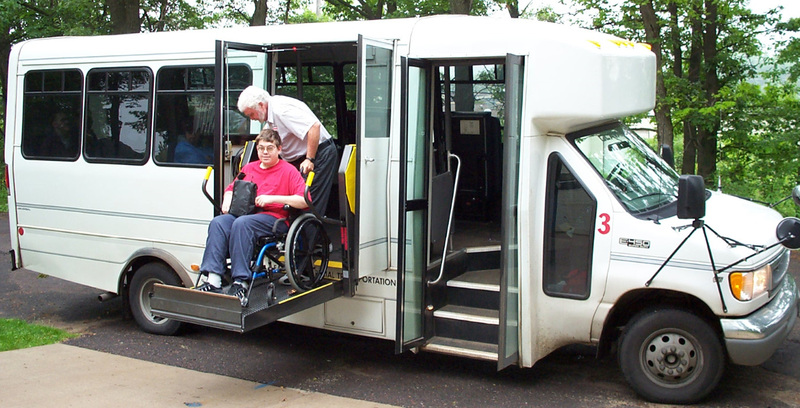ADA in Action Across the Chippewa Valley
Public Services
Private businesses and non-profit organizations that provide goods and services to the public must provide access to people with disabilities. Accessible websites, captioned movies, and wheelchar accessible hotel rooms are just some of the many examples of this.
Cheryl and Jim Korn, shown in the image to the right, demonstrate the kinds of closed captioning equipment available at Micon Cinemas in Chippewa Falls and Eau Claire. Cheryl is using the closed captioning receiver that can be placed in a cup holder. Jim Korn is wearing a closed caption headset receiver glasses where the closed captions appear on the glass lenses. This image, along with an article, originally appeared in the Chippewa Herald online, December 2013.
Government Services
State and local government programs and services must be made accessible to people with disabilities. This applies to both architectural barriers and communication barriers for people with visual, hearing, and speech disabilities. Examples include handicapped parking, ramps, Braille marking on elevators and room signage, and closed captioning on government public service ads.
The image to the left shows the Putnam Heights Neighborhood playground equipment displaying the wheelchair accessible ramp onto the play equipment. The ramp is a slow incline connecting several sections of the equipment, some which feature overhead canopy. This is one of two playgrounds in the Eau Claire area providing wheelchair accessible ramps that support greater accessibility to engage with the playground equipment.
The images below, all from the Eau Claire County Courthouse building, demonstrate ways in which government buildings are made more accessible. The image on the left shows an accessible height drinking fountain, the center image displays an accessible door handle which does not require tight grasping, pinching, or wrist twisting to operate, and the image to the right displays guide railings along a hallway inside the building.
Employment
Private employers of fiteen or more people, state and local government employment agencies and labor unions cannot discriminate against qualified individuals with disabilities in job application procedures, hiring, firing, advancement, compensation, and job training. Qualified means that the person must be able to perform the essential job functions with reasonable accomodations that do not cause the employer undue hardship (e.g. too expensive, or too difficult to achieve).
The Job Accomodation Network (JAN) is the leading source of free, expert, and confidential guidance on workplace accomodations and disability employment issues. Working toward practical solutions that benefit both employer and employee, JAN helps people with disabilities enhance their employability, and shows employers how to capitalize on the value and talent that people with disabilities add to the workplace.
Public Transportation
Access to public transportation can be provided by modifying existing vehicles or providing parallel services like paratransit (provided locally by Abby Vans).
All 22 buses in the Eau Claire Transit fleet are accessible to individuals using mobility devices and who otherwise may have difficulty boarding vehicles. They lower close to the ground, so they are level with the curb and are low floored with no steps to negotiate. All buses also have a ramp for boarding and space available for safe transportation of two individuals who desire to remain seated in their mobility device.
The image to the left, showing an individual in a wheelchair on a lift, highlights the paratransit option of Eau Claire Transit.
Communications
Relay systems and other electronic alternatives are required to make telecommunications accessible to people with hearing and speech disabilities. Emergency information must be provided in ways that are accessible to both blind and Deaf individuals. Closed captions on television programs are becoming more common and some television shows have audio descriptions provided on a supplemental channel (SAP). Large print items, such as menus and other items, can help individuals with vision impairment better engage with the world around them. For example, check out this large print bulletin from Lake Street United Methodist Church in Eau Claire.
Sign-language interpreters also provide opportunities for people with hearing disabilities to participate in live events. Shown below, Rachel Kohn provides sign language interpretation at a campaign event for then Presidential Candidate Barack Obama during a visit to the UW-Eau Claire campus in 2008. Rachel is in focus in the image while Obama, in the foreground, is out of focus.
Service Animals
Dogs that are individually trained to perform specific tasks for a person with a disability are allowed in public places because of the Americans with Disabilities Act. A service animal can be excluded from a place or situation where harm could be expected from its presence, such as in a zoo exhibit where the animals in the exhibit are predators or prey of dogs. Emotional support animals and therapy animals are not covered by the ADA.
Calvin, a Seeing Eye Dog shown in the image to the right, lies on the ground while accompanying Dr. Katherine Schneider, who is blind, while she delivers a lecture on the UW-Eau Claire campus.
Below, you can read the proclamation from Eau Claire County declaring July 26, 2020 as Americans with Disabilities Act Awareness Day in Eau Claire County.








